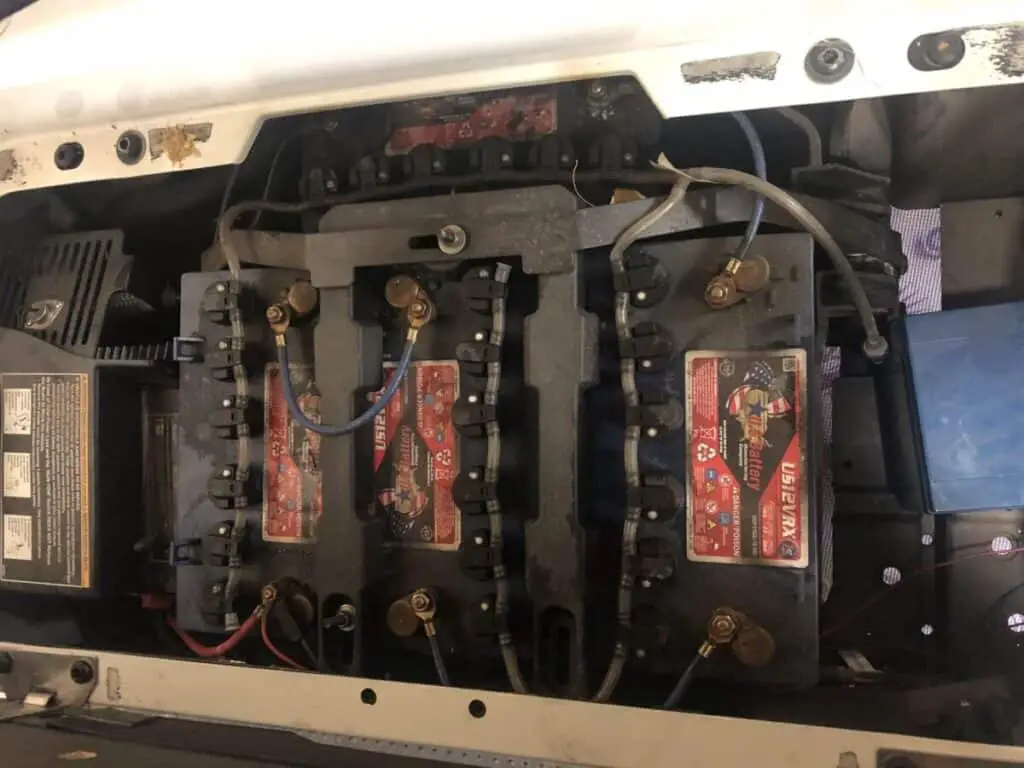If you’ve owned or used a golf cart frequently, you understand that they can be finicky and tricky vehicles with minds of their own. You may have even found that your golf cart goes faster in reverse than it does when it’s moving forward. Whether this is because it’s running especially slow in forward or super-fast in reverse, it could mean something isn’t working properly with your golf cart, and you should repair the issue.
When your golf cart is running faster in reverse than it is in forward, several things could be happening such as: there’s a problem with the wiring, electronics, brakes, bearings, or battery. You’ll have to use a process of elimination to determine the exact cause of the issue.
If your golf cart runs faster in reverse than it does in forward, you’re part of a fairly common group. This is one of the biggest problems people run into with golf carts. In some cases, there’s something wrong with the inner workings of the motor. In other cases, it’s because that’s how your golf cart is designed. Either way, there are methods you can use to get your golf cart running faster in forward than it does in reverse.
Possible Reasons Your Golf Cart is Faster in Reverse Than in Forward
Unfortunately, there are many possible reasons why your golf cart is faster in reverse than it is in forward. To find the root of the problem, you’ll have to go through each of the possibilities and rule them out.
Bad Forward/Reverse Switch
As the name indicates, the forward/reverse switch, also known as the F&R switch, is responsible for determining whether your golf cart goes forward or backward. The issue of a bad F&R switch is more dominant on older carts, but it can also happen with newer ones.
Essentially, if the switch goes bad, it will result in a faulty electrical connection and could cause your cart to go faster in reverse than it does in forward. However, it’s important to test this theory out and see if the F&R switch is working properly.
How to Fix
To test your F&R switch, you’ll need to use a multimeter and follow these simple steps.
- Start by checking for loose wire connections on the F&R switch. Loose connections will result in faulty electrical signals and incorrect speeds.
- If the wires appear tight and intact, use your multimeter to check for continuity.
- Turn the cart on, press your foot on the brake, and check the solenoid for continuity. If it has continuity, it means that your F&R switch is ok.
- Now, do the same thing when you put your cart in forward. If there’s continuity, you’re good to go.
If you do discover that your F&R switch is faulty, you should replace it with a new one. F&R switches aren’t that expensive, and they’re fairly easy to replace on your own. Testing it is the hardest part.
Half-Speed Reverse Lead on Your Controller
Some golf carts have a half-speed reverse lead on their cart controller, which is what controls your speed. The half-speed reverse lead does exactly what its name implies- it cuts your golf cart’s speed in half. However, there are times when the lead only works in forward and not in reverse. When this happens, your golf cart will go twice as fast in reverse as it does going forward.
How to Fix
If you have a half-speed reverse lead on your golf cart that’s bad, you should replace it. However, it’s important to use a multimeter first and check to ensure it’s bad. You should also check the lead and make sure it’s tight and doesn’t have any frayed wiring.
You Crossed Your Wires
While crossed wires are extremely rare with golf carts right out of the factory, they’re very common with people who perform their own golf cart repairs. Crossed wires happen when you’re performing a fix on your golf cart and disconnecting the wires connected to the F&R switch.
You see, your F&R switch has two wires, with one connected to either lead. If the F wire is connected to the R lead, your cart will go faster in reverse than in forward.
How to Fix
Fixing this problem is easy. Simply disconnect the wires from the F&R leads, and swap them. If the problem persists, then crossed wires weren’t your issue. If the problem is fixed, however, you’re good to go.
Loose Battery Connections

It’s also possible that your golf cart battery has loose connections. If the wires aren’t connected properly to the terminals, it could cause your golf cart to move slower. While it will usually move slowly in both forward and reverse, it’s possible that the issue only manifests in forward.
How to Fix
Lift your golf cart seat and check the connections on the battery. If they’re loose, tighten them and charge the cart to see if that was the problem. You should also check the terminals for corrosion, as this can also cause a weak connection between the wires and battery terminals.
Mechanical and Body Issues
There are also a number of mechanical and body issues that could cause a golf cart to go slower in forward than reverse. It’s possible that the brakes are catching, the axles are loose, the bearings are bad, or the bushings are worn. You should check each of these components if nothing else seems to be the problem.
How to Fix
If you encounter a problem with your brakes, bushings, bearings, axles, or any other component of your cart, you should repair or replace it.
Speed Sensor Problem
One of the most common issues with golf carts is that the speed sensor has gone bad. The speed sensor is on the motor of your golf cart and helps to control how fast your cart goes. When it’s acting up, it can cause your cart to go faster in reverse than in forward.
How to Fix
Find the speed sensor on your golf cart motor and check it for visible damage. If you notice rust, corrosion, frayed wires, grease, or a cracked magnet, it’s likely damaged and the source of your troubles. It’s also possible that there’s an electrical malfunction with the sensor that will show up as a fault code. If any of these things are the issue, you’ll have to replace the speed sensor.
Why Does My Golf Cart Go Slow in Forward?
The most common reason that your golf cart is moving slowly when it’s in forward is because of low battery charge. However, you should put the cart in reverse and see if it goes at a similar speed or is much faster. If it’s faster in reverse than in forward, one of the above issues is likely the culprit.
How Can I Slow Down My Golf Cart?
If your golf cart is going too fast for comfort, your best option to slow it down is to install a half-speed reverse lead. Installing this device will safely cut your golf cart speed in half and help you feel more comfortable. You can also install a “governor” on the motor, which will ensure that your cart doesn’t exceed a certain speed.
How do You Adjust the Speed on a Golf Cart?
Whether you want your golf cart to go faster or slower, here’s the procedure to follow.
- Lift the golf cart seat.
- Remove the seat cushions from atop the motor.
- There’s a black plastic cover over the motor that you’ll have to remove.
- With the motor exposed, locate the governor spring.
- Loosen the small nut on the governor spring and tighten the larger one to make your cart run faster. To make it go slower, perform the reverse operation.
How do You Adjust a Speed Controller on a Golf Cart?
The speed controller on your golf cart is another name for the governor. You can adjust it by using the same methods that we listed above related to speed adjustment.

